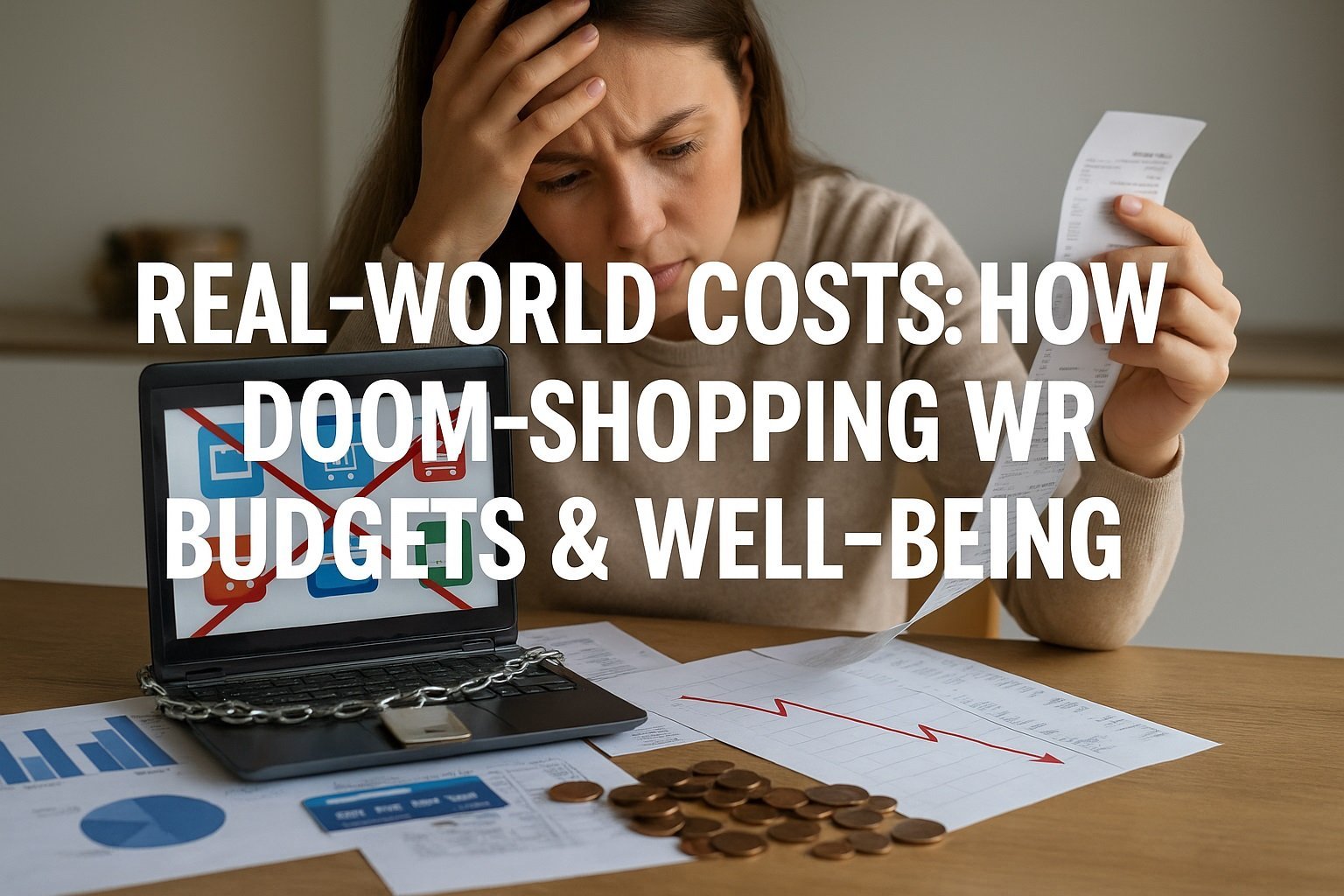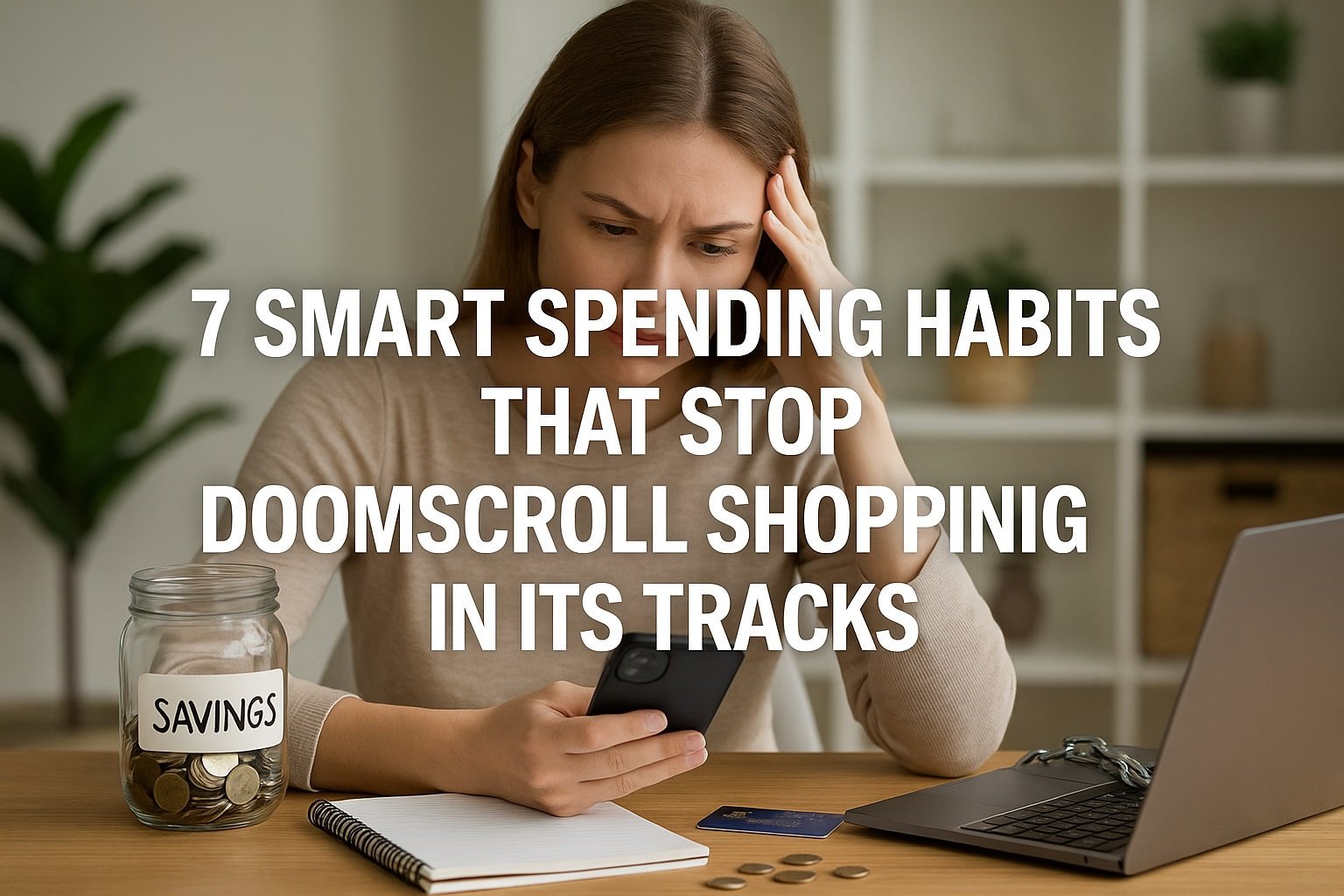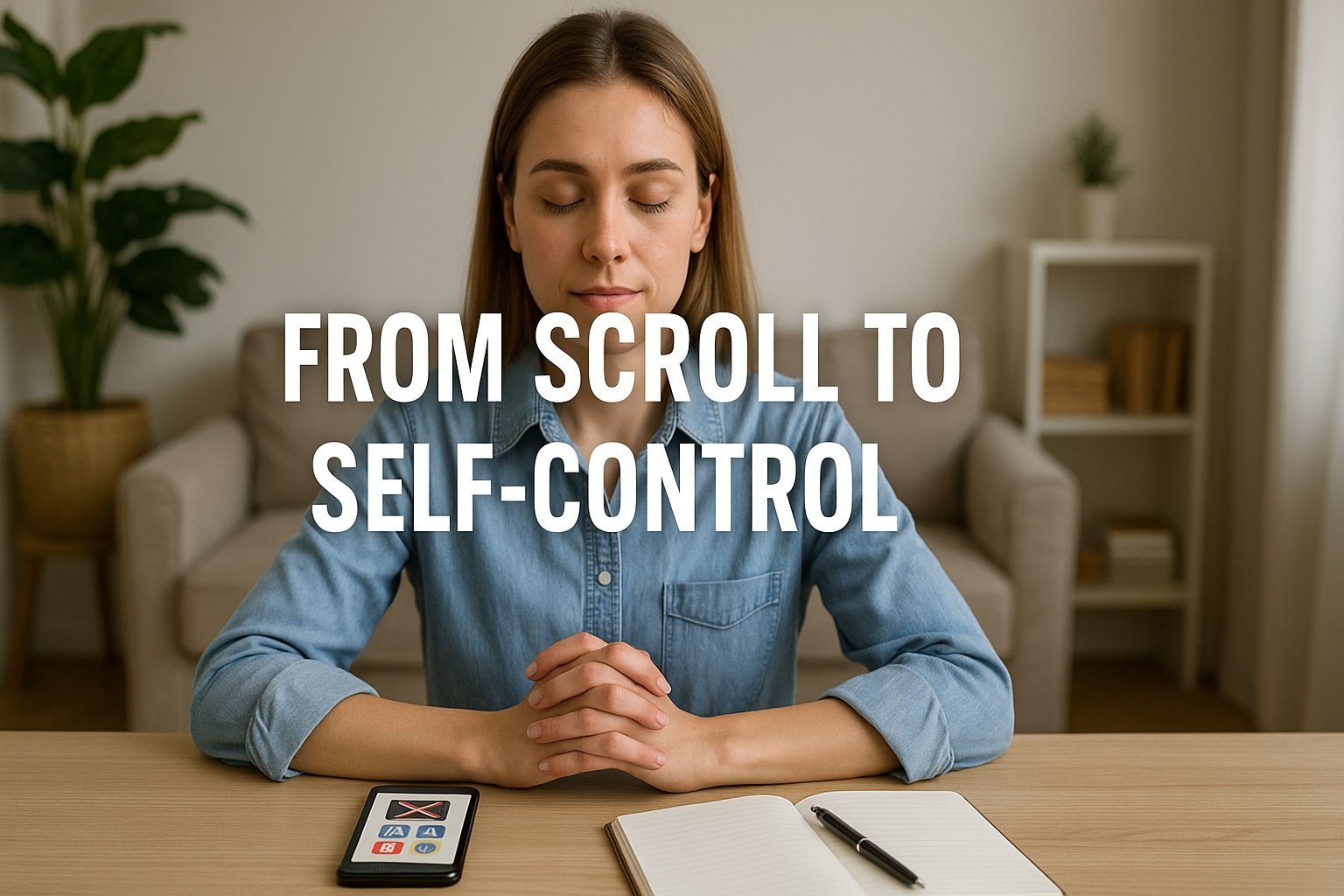Ever found yourself endlessly scrolling through feeds, your finger hovering over “Buy Now”, only to feel a pang of regret thirty seconds later? That’s doomscroll shopping in action – the cycle of stress-induced browsing followed by impulse purchases that spike your dopamine but drain your savings. In uncertain times, a quick purchase can feel like taking back control, yet it often leaves us poorer and more anxious.
In this article, you’ll get a step-by-step toolkit drawn from top personal finance and psychology experts at Bankrate, Ramsey Solutions, the Washington Post, Psychology Today and more to help you build smart spending money habits that break the scroll-buy habit, save you cash, and reclaim your time without sacrificing the thrill of discovery. Let’s dive in.
What Is Doomscroll Shopping (and Why You’re Wired to Do It)
When bad news floods your screen, your brain craves a pick-me-up, and that’s where a quick checkout click comes in. Research shows that each purchase delivers a small hit of dopamine, the neurotransmitter tied to reward and pleasure, reinforcing the urge to shop whenever stress strikes. Over time, decision fatigue sets in; your mental energy for weighing pros and cons wears thin, so impulse wins out more often than not.
Economic uncertainty only makes things worse. In volatile markets or a shaky job climate, spending on small comforts feels like reclaiming control. Unfortunately, these “retail therapy” bursts often lead to buyer’s remorse and a thinning bank balance rather than genuine relief. Recognising the brain science behind this loop is the first step toward smarter spending money habits to stop doomscroll shopping.
Real-World Costs: How Doom-Shopping Wrecks Budgets & Well-Being

When you give in to that late-night urge to click “buy”, it can feel harmless in the moment. But behind each quick purchase lurk hidden costs that chip away at both your finances and your peace of mind.
Hidden Interest, Clutter, Buyer’s Remorse
First, think about the way small impulse buys add up over time. Even if you pay off your credit card balance in full each month, carrying a balance or forgetting to pay can saddle you with interest charges that push today’s $20 gadget into tomorrow’s $25 or $30 reality. Beyond the financial hit, those impulse items often arrive and sit in a drawer or closet, reminding you of that fleeting thrill and the waste that followed. Clutter doesn’t just crowd your space; it crowds your thoughts, too, increasing stress every time you open the closet door. And when buyer’s remorse sets in – ‘Why did I need this? – you’ve not only lost money, you’ve also lost confidence in your spending choices.
Opportunity Cost vs. Long-Term Goals
Every dollar spent on a nonessential purchase is a dollar diverted from something that truly matters to you. That latte-and-trinket habit could be the difference between hitting your emergency-fund target or falling short when an unexpected repair pops up. It could delay a down payment on a home, postpone paying off high-interest debt, or slow the growth of your retirement nest egg. In other words, doom-shopping doesn’t just drain your bank account today; it sacrifices progress on tomorrow’s goals. Viewing each impulse buy through the lens of opportunity cost “What else could I do with this $30? turns a mindless click into a mindful decision.
By bringing these real-world costs into focus, you’ll see that every impulse buy carries more than its sticker price. Recognising the full impact helps you choose a healthier, happier path – one where your money works for your goals, not against them.
7 Smart Spending Habits That Stop Doomscroll Shopping in Its Tracks

Ready to turn impulse into intention? Try weaving these simple habits into your routine. Each one adds a built-in pause or guardrail between the scroll and the sale.
Habit Key Action
| Habit | Key Action |
|---|---|
| 24-Hour Pause Rule | Add the item to the wishlist; only checkout tomorrow if it’s still essential. |
| Pre-Commit Shopping Budget | Set aside a fixed “fun money” envelope or app sub-budget each month. |
| Wishlist Instead of Cart | Save items to a dedicated wishlist for a weekly review session. |
| Mindful Spending Reflection | Before buying, ask: “Do I really need this? Can I enjoy it cheaper? How will I feel tomorrow?” |
| Track Impulse Buys | Log every unplanned purchase in a spending journal for monthly review. |
| Habit Substitution | When the urge hits, swap scrolling for a five-minute walk or call a friend. |
| Automate Savings & Donations | Use round-up features and auto-transfer to savings or a cause you care about. |
Each of these habits brings just enough friction to stop the scroll-buy reflex and steer you toward choices you’ll feel good about. Pick one to start, then layer in the rest; your wallet (and your peace of mind) will thank you.
Curate Your Feeds
One of the simplest yet most effective habits is to curate your digital environment so you never see that tempting “Shop Now” button in the first place. Start by unfollowing retailer and brand accounts on social media. If you’re not constantly bombarded with glossy product posts, you won’t feel the itch to scroll for deals. Next, disable push notifications from shopping apps; those little pop-ups about flash sales are engineered to trigger impulse buys before you even realise what’s happening. Finally, lean on your inbox filters: create a rule that sends promotional emails straight to a “Deals” folder instead of your main view. Then, you can choose to check that folder on your own terms. Say, once a week, so you stay in control of when and why you’re exposed to sales pitches, rather than letting them hijack your day.
No-Buy / Low-Buy Challenge
One of the most powerful ways to freeze the scroll-buy reflex is to launch a no-buy or low-buy challenge. Pick a clear, time-boxed window – a weekend, a week, or even a month – and commit to spending only on true essentials. Then rope in an accountability buddy: share your start and end dates, check in daily on progress, and celebrate small wins together. When the urge to click “add to cart” strikes, you’ll know you owe a quick report to your partner in crime, which adds just enough social pressure to short-circuit impulse buys. Over time, you’ll discover how little you really need and build confidence in steering clear of doomscroll shopping.
Cash‑Stuffing “Fun‑Money” Envelope
With the cash-stuffing “fun-money” envelope, you give yourself permission to spend guilt-free – just not with plastic. Each week, pull out a set amount of discretionary cash (think $20 or whatever fits your budget) and tuck it into an envelope labelled “Fun Money”. Then leave your debit and credit cards at home or tucked away in a drawer so the only way to buy that extra treat is with the cash you preloaded. Watching the bills disappear makes you more mindful of each purchase, and when the envelope runs dry, that’s it for the week. This simple ritual reins in doomscroll shopping by putting a clear cap on impulse buys and giving you a tangible sense of control over your money.
Screen-Time & App Limits
Putting your phone in a “digital prison” might sound dramatic, but it works. Start by enabling downtime settings on your device so shopping and social apps are off-limits during chosen hours, perhaps first thing in the morning or late at night when doomscroll urges peak. Switch your screen to greyscale so those bright sale banners lose their appeal. If you try to open a shopping app and see a dull, colourless icon, you’ll be less inclined to tap through for another impulse buy. Over time, these simple tech tweaks rewire your habits by inserting natural pauses and making shopping less visually enticing.
Dopamine Swap
Impulse purchases feel good because they trigger a quick dopamine hit. The trick is to swap the scroll-buy reward for something healthier. Next time you feel the itch to browse deals, pause and choose a mood-booster instead: take a brisk walk around the block, crack open a good book for ten minutes, or call a friend for a quick chat. These activities deliver genuine uplift without draining your wallet. By consciously replacing the click-and-checkout reflex with a positive habit, you retrain your brain to seek joy in experiences rather than items.
Accountability & Reflection
Keeping a weekly spend journal turns your impulse buys into data points you can learn from. At the end of each week, list every unplanned purchase and note what emotion drove it (boredom, stress, or excitement). Then celebrate your successes: mark any zero-spend days with a gold star or reward yourself with a free treat like a favourite podcast episode. This combination of honest reflection and positive reinforcement makes you more aware of your patterns and motivates you to keep growing your smart spending muscles. Over time, you’ll see fewer red-ink weeks and more green-light victories.
Step-by-Step Toolkit: From Scroll to Self-Control

Ready to turn awareness into action? This toolkit walks you through each stage so you can stop impulse buys before they start.
Pre-Purchase Checklist
Before you tap “Buy Now”, run through these five quick questions:
-
Do I need it or just want it? If it’s purely “want”, pause.
-
Is there a less expensive alternative? Comparison shopping can save you hundreds.
-
Will I still care about this tomorrow? Give yourself permission to wait.
-
Does it fit into my budget right now? If it blows your plan, it’s a no-go.
-
What emotion am I feeling? Name it – stress, boredom, FOMO – and ask if shopping really helps.
Tech Guardrails
Install browser plug-ins that block checkout pages or hide prices temporarily. Some extensions let you restrict access to shopping sites during chosen hours. On your cards, activate “lock” features that require a quick PIN or toggle in your banking app before any online purchase. That extra step often gives you enough time to rethink an impulse.
Zero-Based Budget Template
With zero-based budgeting, every dollar has a job, even your “fun money”. Start by listing all income, then assign every dollar to categories like essentials, debt pay-down, savings and discretionary spending. Here’s a simple layout you can recreate in a spreadsheet or budgeting app:
| Category | Amount ($) |
|---|---|
| Housing & Utilities | 1,200 |
| Food & Groceries | 400 |
| Debt Payments | 250 |
| Emergency Savings | 150 |
| Fun-Money Envelope | 50 |
| Long-Term Goals | 100 |
| Total Income | 2,150 |
Adjust the numbers to fit your earnings. Once you see “fun money” as a line item, impulse buys fit neatly into their own bucket instead of creeping into essentials.
Progress Tracker
Logging wins (and near misses) keeps you motivated. Create a simple spreadsheet with columns for date, item avoided, amount saved and emotion noted. Or use a habit-tracking app that lets you check off “no impulse buy” each time you resist. Reviewing this log weekly shows you how often you choose self-control and that momentum fuels more smart decisions.
When to Seek Extra Help

Most of us nip impulse shopping in the bud with these habits. But if you notice that unplanned purchases are hijacking your life – burning through pay cheques, straining relationships or causing anxiety – you might be dealing with compulsive buying disorder. Look out for these red flags:
-
Shopping to soothe negative moods or escape stress, even when you can’t afford it
-
Repeated attempts (and failures) to cut back on spending
-
Hiding purchases or lying about how much you spend
If that sounds familiar, reach out for support. Financial coaches at organisations like All About Interventions can help you rebuild healthy money habits, while therapists listed on My Wellbeing offer strategies to manage underlying emotions. You don’t have to go it alone.
Key Takeaways & Quick-Start Checklist
In three minutes, you can remind yourself of the core habits that stop doomscroll shopping:
-
Pause Before Purchase: Use the 24-Hour Rule and pre-purchase checklist.
-
Build Friction: Install tech guardrails and disable one-click buying.
-
Budget with Purpose: Zero-based budget includes “fun money”.
-
Track and Reflect: Log avoided impulses and celebrate progress.
-
Curate Your Feed: Unfollow retailers, mute notifications.
Grab your own fill-in-the-blanks toolkit to guide each step and watch your scroll-buy reflex transform into intentional, confident spending.
FAQ Section
| Question (H3) | Answer Summary |
|---|---|
| What is doom spending/doomscroll shopping? | Stress-driven impulse buying triggered by negative online content. |
| How do I stop impulse buying at night? | Use app curfews, wish lists and the 24-hour rule. |
| Why does shopping make me feel better then worse? | Dopamine surge followed by guilt and financial anxiety. |
| Is a no-buy challenge realistic for beginners? | Start with a 7-day micro-challenge; pair with an accountability partner. |
| What are smart spending habits in general? | Budgeting, needs vs. wants, automated saving, mindful purchasing. |
